Top 10 Wildlife Safari in Rajasthan: Best Time, Safari Fees, etc
Discover the diverse experiences in Rajasthan – the land of kings known not only for their regal history but also for the untamed wildlife safari in Rajasthan. No wonder, most of the Rajasthan Tours or the Golden Triangle Tours include a wildlife safari in the popular Ranthambore National Park.
Beyond the historic palaces and forts of Rajasthan lies an adventurous side of this incredible state waiting to be explored through a thrilling wildlife safari. The national parks and wildlife sanctuaries that we see today in Rajasthan once served as the royal hunting grounds for the former rulers, which itself adds a touch of history to the wildlife jungle safari in Rajasthan.
So, get ready to embark on an enchanting journey into the heart of Rajasthan’s wildlife tourism, where majestic creatures roam freely against a backdrop of diverse landscapes. Whether you’re drawn to Ranthambore National Park, Sariska Wildlife Sanctuary, or other hidden gems, each reserve area is steeped in both natural splendor and historical significance.
The combination of royal heritage and untamed wilderness creates an unparalleled experience for nature enthusiasts and adventure seekers alike. From elusive tigers prowling through the dense foliage to the graceful movements of migratory birds, a wildlife safari in Rajasthan promises an unforgettable experience.
Feel the adrenaline rush on your wildlife safari as you embark on this thrilling adventure activity in Rajasthan, where you will witness the untamed wildlife in full glory. A wildlife jungle safari in Rajasthan awaits, inviting you to witness the harmony of nature and history in a truly immersive and unforgettable adventure.
10 Best Wildlife Safari in Rajasthan
1. Ranthambore National Park, Sawai Madhopur

The top place when you think of the best wildlife safari in Rajasthan is the popular Ranthambore National Park. It is the largest and the most-visit national park in Rajasthan. People flock to this place in large numbers to listen to the story of the most photographed tigress in the world who belonged to this forest.
Established as Sawai Madhopur Game Sanctuary in 1955, it later attained the status of a national park in 1980. Covering an expansive area of around 1,334 square kilometers, the park is a haven for wildlife enthusiasts and a crucial part of the erstwhile royal hunting grounds. Another major attraction in this national park is the majestic Ranthambore Fort – a UNESCO World Heritage Site in Rajasthan.
- Wildlife To Watch Out For: Royal Bengal tiger, leopards, sloth bears, crocodiles, striped hyenas, and over 270 species of birds.
- Best Time To Visit: The best time to visit Ranthambore is from October to April. During these months, the weather is pleasant, and the animals are more active, offering visitors an unforgettable safari experience.
- Safari Fees/ Entry Charges: Ranthambore offers various safari options, including Jeep Safari (6 People Max) and Canter Safari (20 people).
- Jeep Safari: ₹1800 (Indians), ₹3700 (Foreigners)
- Canter Safari: ₹1200 pp (Indians), ₹2700 pp (Foreigners)
- How To Reach?
The nearest airport to Ranthambore is Jaipur International Airport, approximately 155 kilometers away. Sawai Madhopur Railway Station is the nearest railhead, situated around 14 kilometers from the park. Both transportation hubs provide convenient access to this wildlife haven through roadways, inviting visitors to embark on a thrilling journey into the heart of nature.
2. Bharatpur Bird Sanctuary, Bharatpur (Keoladeo Ghana Bird Sanctuary)

Popular as a UNESCO World Heritage Site in Rajasthan and the largest bird sanctuary in Asia – the Bharatpur Bird Sanctuary is a delight for bird watchers across the world. If your heart craves the melody of fluttering wings and vibrant feathers, the Bharatpur Bird Sanctuary, also known as Keoladeo Ghana Bird Sanctuary, is a must-visit for a wildlife safari in Rajasthan.
Originally a hunting ground for the maharajas, the sanctuary was established as a bird sanctuary in 1956. Spanning approximately 29 square kilometers, it’s a wetland paradise that teems with migratory birds, especially during the winter months.
- Wildlife To Watch Out For: Home to over 370 species of birds, the sanctuary is a spectacle of feathers. Siberian Cranes, Painted storks, Pelicans, Herons, and various Waterfowl add to the vibrant diversity.
- Best Time To Visit: The best time to explore this avian sanctuary is from October to March when the migratory birds arrive to escape the harsh winter of their native habitats. The weather during these months is pleasant, enhancing the overall birdwatching experience.
- Safari Fees/ Entry Charges: Entry fees for Indians are ₹75, while foreigners are charged ₹500. The sanctuary is open from sunrise to sunset, providing ample time for birdwatching enthusiasts to soak in the natural beauty. Safaris are done by Cycles, Cycle Rickshaws, and Horse Tongas. Walking is also allowed inside the park. You can hire these modes of transportation on an hourly basis at the entrance of the park at an additional cost.
- How To Reach?
The nearest airport is Agra Airport, approximately 56 km away, while Bharatpur Junction is the closest railway station at a distance of just 6 km. Well-connected by road, the sanctuary is easily accessible, inviting bird enthusiasts to immerse themselves in the beauty of nature.
3. Jhalana Leopard Reserve, Jaipur
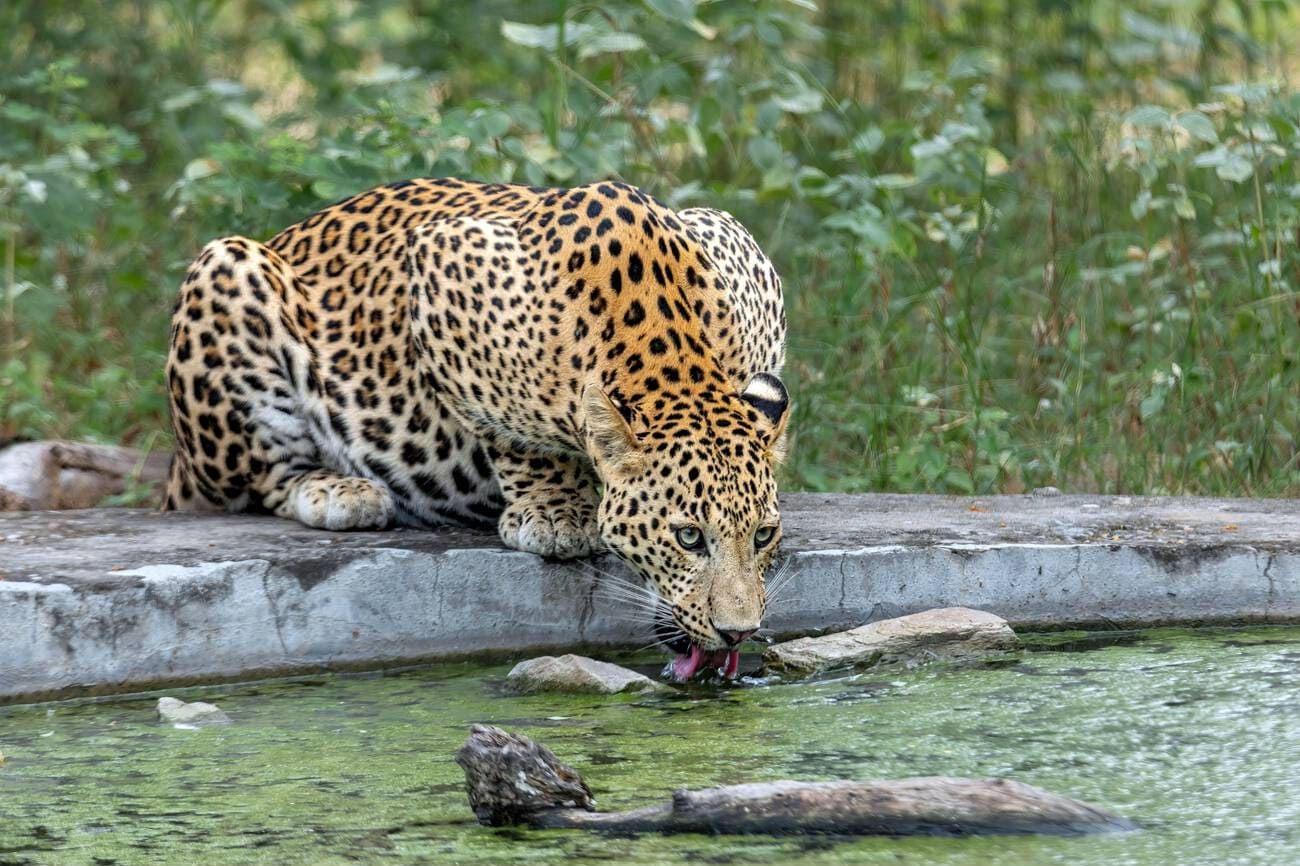
One of the top places to visit in Rajasthan’s capital city Jaipur is the Jhalana Leopard Reserve for a thrilling leopard wildlife safari. While Rajasthan is famed for its tigers, Jhalana offers a unique safari experience focused on the elusive and majestic leopards. This reserve, nestled in the Aravalli hills, adds a touch of wild magic to the Pink City’s landscape.
Originally a private hunting ground, Jhalana transformed into a conservation reserve in 2016. Extending over an area of 24.7 square kilometers, it has become a haven for leopard enthusiasts and wildlife photographers seeking the thrill of spotting these elusive cats.
- Wildlife To Watch Out For: Jhalana Leopard Reserve is a sanctuary for leopards, but it’s not just about the big cats. The reserve is also home to a variety of wildlife, including striped hyenas, desert foxes, nilgai, and a myriad of bird species, making it a biodiversity hotspot.
- Best Time To Visit: The best time to explore Jhalana is during the winter months, from October to March. The weather is pleasant, and the chances of leopard sightings are higher during this period. The morning and evening safaris offer optimal conditions for observing wildlife in their natural habitat.
- Safari Fees/ Entry Charges: Jhalana provides an intimate safari experience with limited vehicles. The entry fee for Indian tourists is ₹200, and for foreign tourists, it’s ₹1000. The safari timings are divided into morning and evening slots, ensuring an immersive wildlife encounter.
- How To Reach?
Jhalana Leopard Reserve is conveniently located near Jaipur, with Jaipur International Airport being the nearest air transit point, just 5 kilometers away. Visitors can also reach the reserve via Jaipur Junction, the main railway station in the city which is just 10 km. A short drive from the bustling city, Jhalana invites you to step into the wild side of Jaipur and witness the grace of leopards in their natural habitat.
4. Sariska Tiger Reserve, Alwar
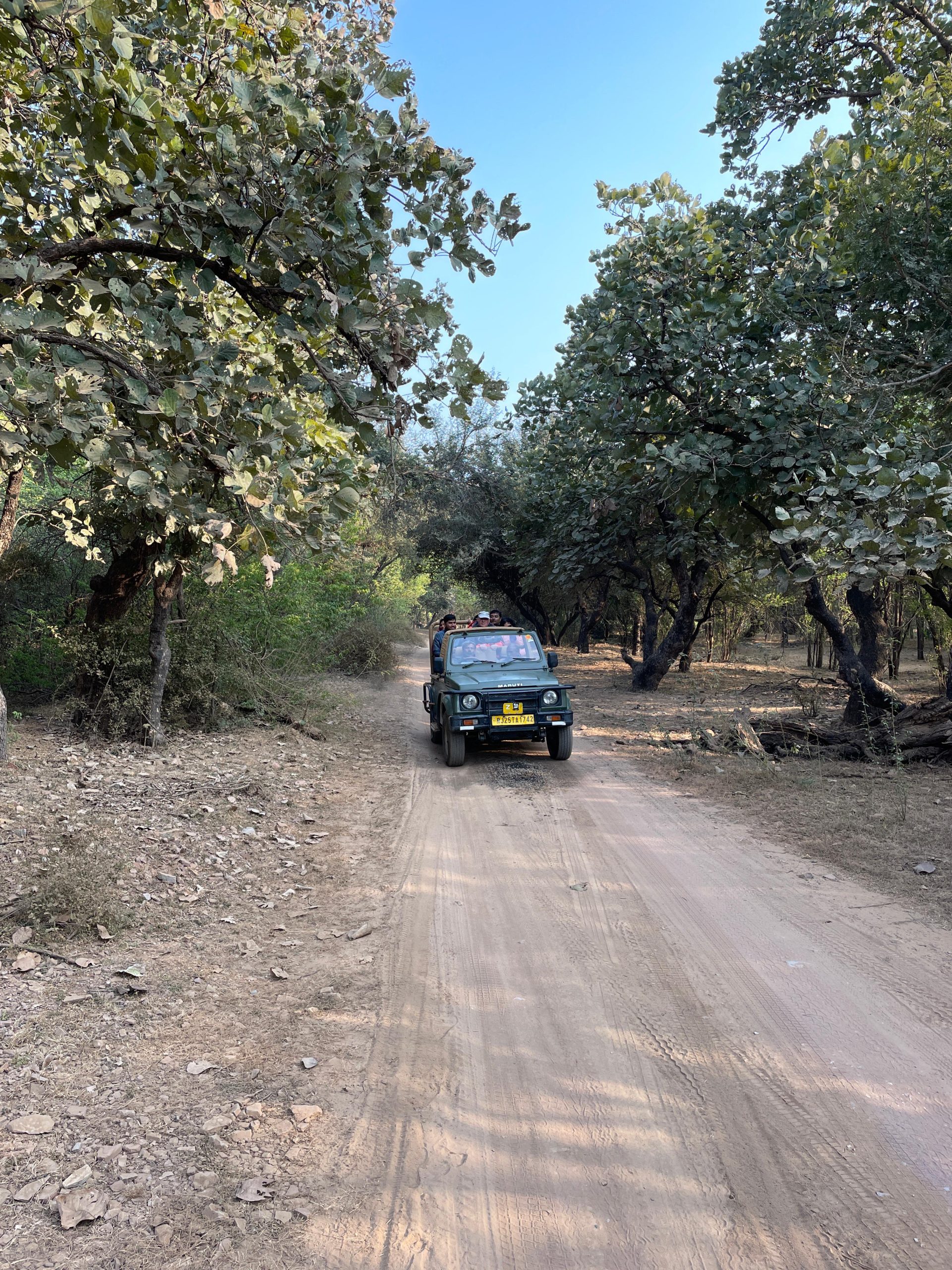
Escape into the wilderness of Sariska Tiger Reserve, a captivating sanctuary nestled in the Aravalli range near Alwar. This reserve, initially a hunting ground for the royals, has evolved into a crucial wildlife conservation area, offering a thrilling wildlife safari in Rajasthan for nature enthusiasts.
Originally a hunting ground for the Maharajas of Alwar, Sariska was declared a wildlife sanctuary in 1955 and later became a Tiger Reserve in 1978. Spanning an area of around 866 square kilometers, it is now a vital habitat for diverse flora and fauna.
- Wildlife To Watch Out For: Sariska is renowned for its Royal Bengal tigers, making it a prime destination for wildlife enthusiasts. Besides tigers, the reserve houses leopards, caracale, chital, nilgai, langur, jackal, jungle cats, hyenas, sambar deer, and various bird species, making it one best wildlife safari in Rajasthan.
- Best Time To Visit: For the best experience of wildlife jungle safari in Rajasthan’s Sariska Reserve, plan your visit to Sariska between October and June. The winter months, from November to February, are particularly pleasant, offering a comfortable climate for exploring the reserve.
- Safari Fees/Entry Charges: Embark on an exciting safari adventure with options like Jeep Safari and Canter Safari. For Indian tourists, the entry fee is INR 120, while foreign tourists are charged INR 450.
- Jeep Safari: ₹1050 (Indians) and ₹2100 (Foreigners)
- Canter Safari: ₹750 per person (Indians) and ₹1500 per person (Foreigners).
- How To Reach?
Sariska Tiger Reserve is easily accessible from Alwar, which is well-connected by road and rail. The nearest airport is Jaipur International Airport, approximately 110 kilometers away. From Alwar Junction, the reserve is 37 km away and can be reached by a scenic drive through the Aravalli hills, inviting you to embark on a wildlife odyssey in the heart of Rajasthan.
Also Read: Hot Air Ballooning In Rajasthan: 5 Places For Aerial Adventure
5. Desert National Park, Jaisalmer
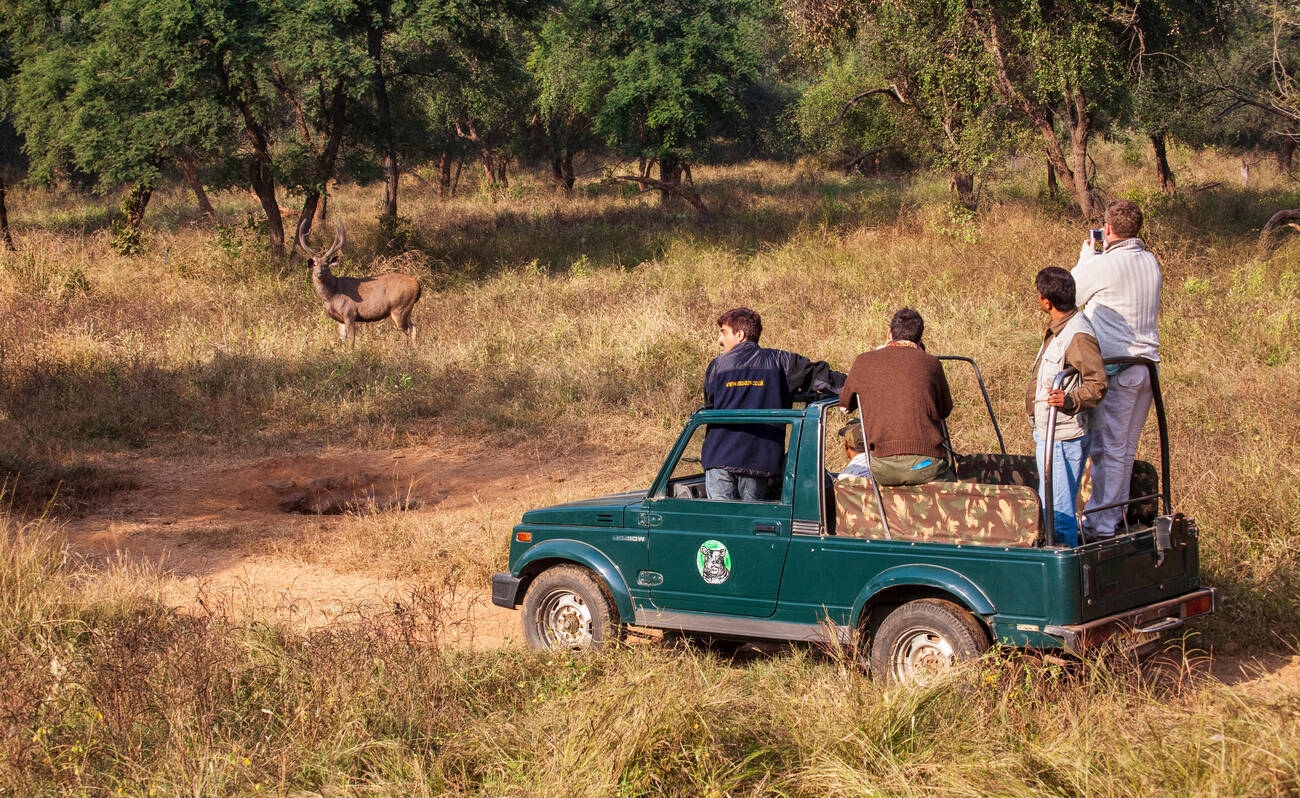
One of the most adventurous places to visit in Jaisalmer is the Desert National Park, a captivating sanctuary in the golden realms of Jaisalmer. This unique desert ecosystem, established in 1980, unfolds a fascinating tale of survival in the arid expanses of Rajasthan and allows you to witness its unique desert wildlife during this wildlife safari in Rajasthan.
Envisioned to preserve the fragile desert ecology, Desert National Park spans over 3,162 square kilometers. Established to safeguard the diverse flora and fauna of the Thar Desert, it has become a sanctuary for those seeking the allure of the desert wilderness.
- Wildlife To Watch Out For: In this vast expanse of sand dunes, Desert National Park is home to a range of wildlife, including the elusive Indian Bustard, desert foxes, blackbuck, and a myriad of reptiles. The park is a birdwatcher’s paradise, offering sightings of vultures, eagles, and numerous migratory birds.
- Best Time To Visit: The best time to explore the Desert National Park is during the winter months, from November to March, when the weather is pleasant. This period is ideal for birdwatching and experiencing the unique desert landscapes without the scorching heat.
- Safari Fees/Entry Charges: The entry charges for this top thing to do in Jaisalmer are ₹100 for Indian tourists, while foreign tourists pay ₹500. Tourists have to pay an additional charge of ₹100 for jeep safari here. The park is open from sunrise to sunset, allowing visitors to witness the changing hues of the desert under the golden rays of the sun.
- How To Reach?
Jaisalmer, known for its splendid architecture, serves as the gateway to the Desert National Park. The nearest airport is Jaisalmer Airport, approximately 55 kilometers away, and the city is well-connected by road and rail. Set out on a mesmerizing journey to this desert sanctuary, where the undulating dunes and the stark beauty of the Thar Desert await your exploration.
6. Kumbhalgarh Wildlife Sanctuary, Rajsamand
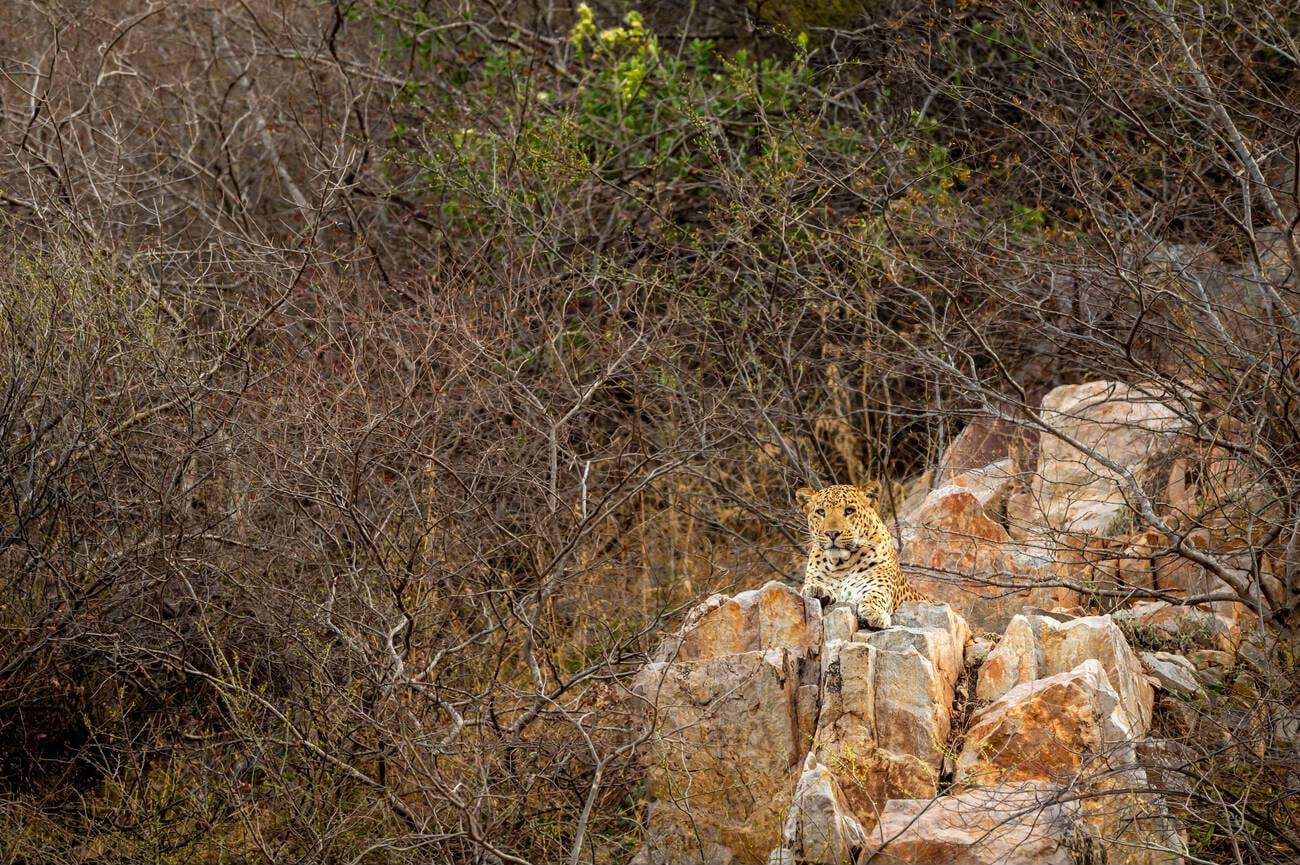
Embark on a wildlife jungle safari in Rajasthan in the serene landscapes of Kumbhalgarh Wildlife Sanctuary, a hidden gem nestled in the heart of Rajsamand. Enriched with diverse flora and fauna, this sanctuary offers a tranquil retreat for nature enthusiasts.
Established in 1971, Kumbhalgarh Wildlife Sanctuary surrounds the UNESCO Heritage Site of the majestic Kumbhalgarh Fort and spans over 611 square kilometers. Initially created to protect the fort’s surroundings, it has evolved into a haven for various wildlife species.
- Wildlife To Watch Out For: Dive into the sanctuary’s rich biodiversity, which includes leopards, wolves, sloth bears, and numerous species of deer. The sanctuary is also a birdwatcher’s paradise, with a variety of birds like junglefowl, peacock, parakeet, and red spurfowl adds melody to the serene atmosphere.
- Best Time To Visit: The sanctuary is most enchanting during the winter months, from October to March, when the weather is pleasant, and wildlife is more active. The cool breeze carries the sweet symphony of nature, creating an ideal environment for exploration.
- Safari Fees/ Entry Charges: Kumbhalgarh offers jeep safaris for a close encounter with its wildlife. The sanctuary entrance fee is ₹100 per person, while the Jeep Safari will cost around ₹2500 per jeep (6 seater).
- How To Reach?
Rajsamand, the gateway to Kumbhalgarh, is well-connected by road. The nearest railway station is in Udaipur, approximately 83 kilometers away. The closest airport is Maharana Pratap Airport in Udaipur which is 96 km away. A scenic drive through the Aravalli hills brings you to this sanctuary, inviting you to unwind in the lap of nature and explore the cultural heritage surrounding Kumbhalgarh Fort.
7. Jawai Leopard Reserve, Jawai Bandh Pali
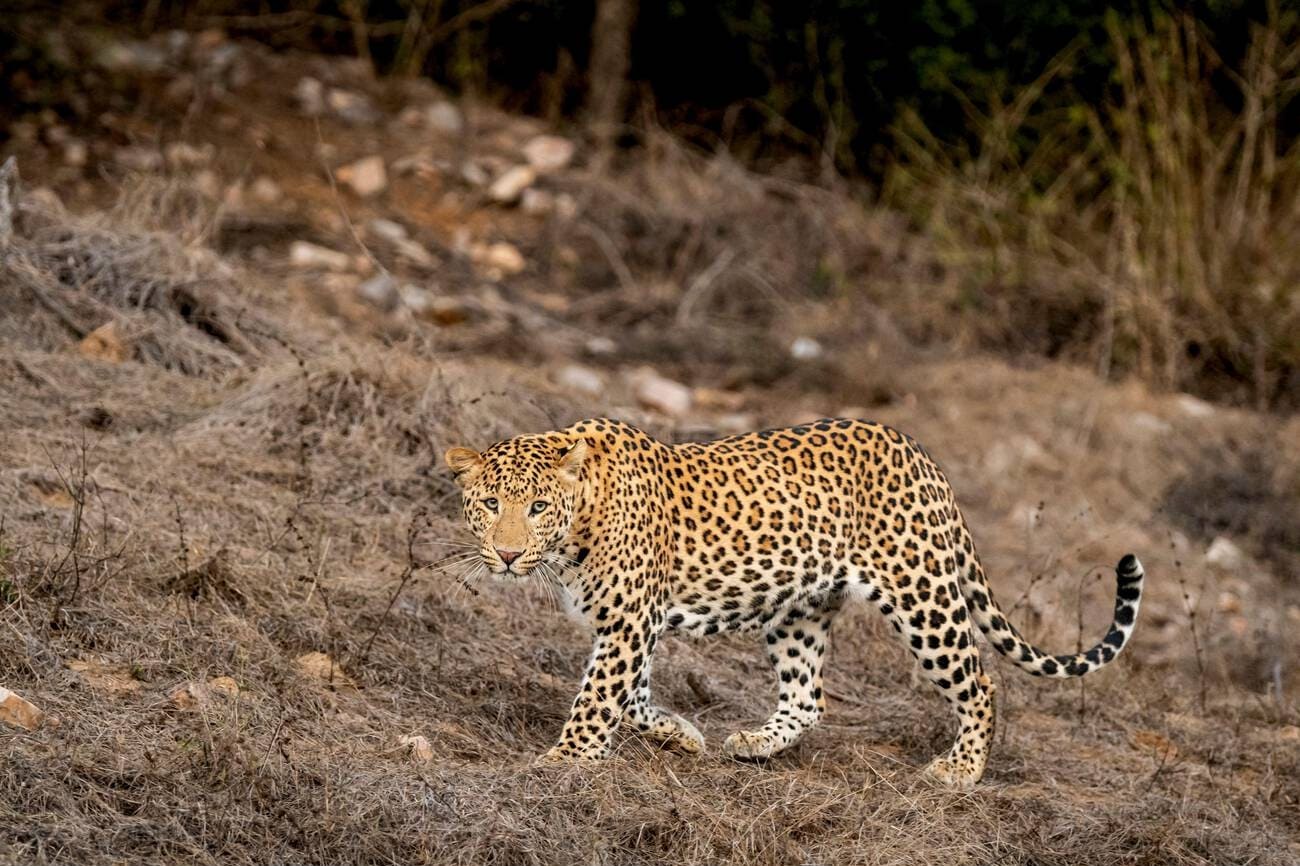
Step into the captivating wilderness of Jawai Leopard Reserve, nestled in the enchanting landscape of Jawai Bandh in Pali. This reserve offers a unique wildlife safari in Rajasthan allowed visitors to witness the elusive leopards against the backdrop of rustic rural life.
Established to protect the leopards and their natural habitat, Jawai Leopard Reserve is one of the top places to visit in Rajasthan during monsoon due to its scenic beauty and has become a haven for wildlife enthusiasts. The rocky terrain and water bodies create a picturesque setting for both leopards and visitors.
- Wildlife To Watch Out For: Jawai is renowned for its thriving leopard population. Beyond leopards, the reserve is also home to various species of birds, Indian striped hyenas, and a range of flora that adds to the diversity of this unique ecosystem.
- Best Time To Visit: The best time to explore Jawai Leopard Reserve is from October to March when the weather is pleasant. During this period, leopards are often spotted basking on the rocks, offering visitors an incredible opportunity for wildlife sightings.
- Safari Fees/ Entry Charges: Jawai offers jeep safaris costs around ₹4000 per jeep (6 seater), allowing a close encounter with leopards and other wildlife in their natural habitat. The experience is complemented by the scenic beauty of Jawai Bandh, creating a memorable adventure for nature lovers.
- How To Reach?
The nearest airport is Udaipur Airport, approximately 150 kilometers away, and the closest railway station is in Faalna, around 50 kilometers from Jawai. Well-connected by road, the reserve is accessible from major cities in Rajasthan.
8. Mount Abu Wildlife Sanctuary, Mount Abu
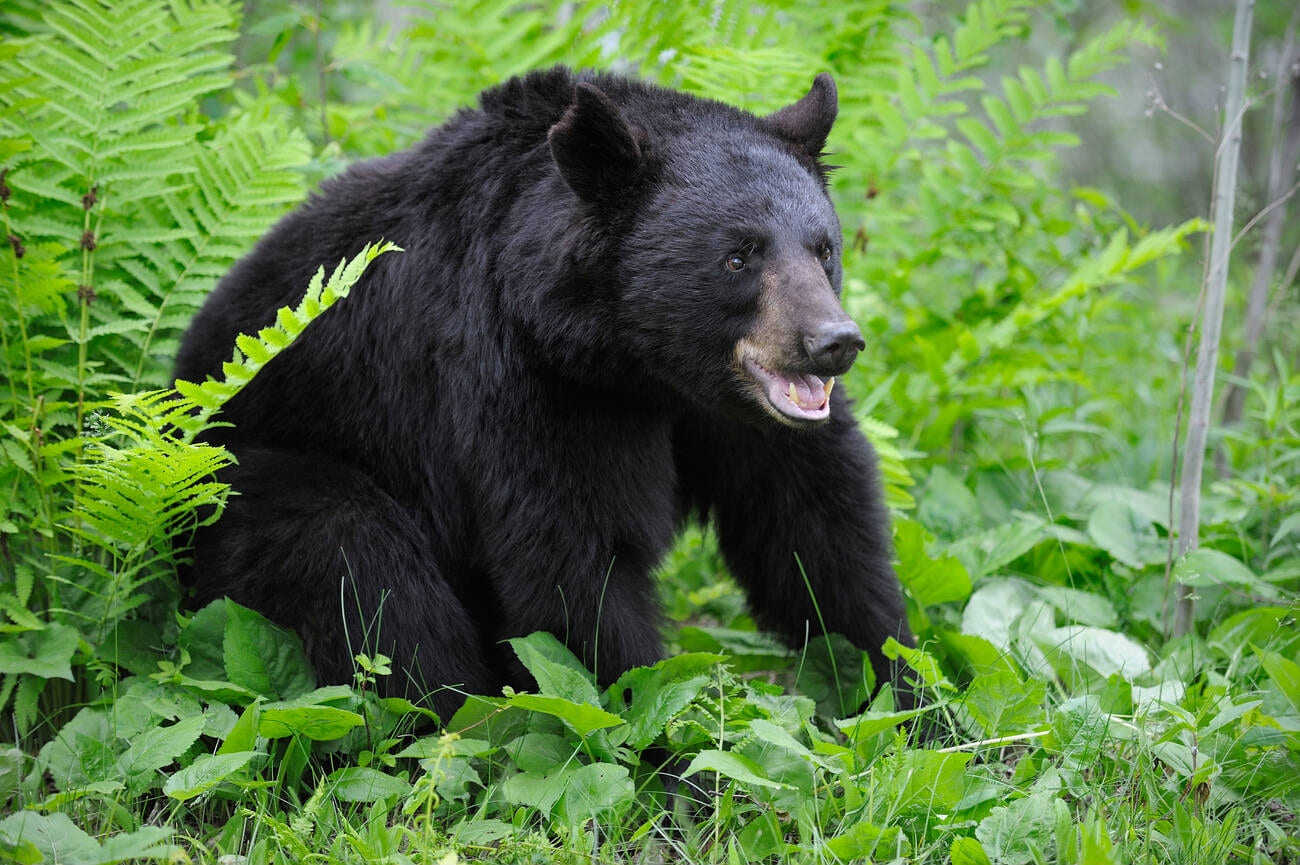
Explore the serene beauty of Mount Abu Wildlife Sanctuary, a verdant oasis in the Aravalli Range, adding a unique charm to the desert landscape of Rajasthan. The sanctuary offers a peaceful escape, inviting you to witness the harmony of nature in the refreshing landscapes of Rajasthan’s only hill station.
Established in 1960, the Mount Abu Wildlife Sanctuary spans over 288 square kilometers, providing a lush retreat in the only hill station of Rajasthan. Originally the royal hunting ground of the Maharaja of Jaipur, it is now a protected area for diverse flora and fauna.
- Wildlife To Watch Out For: The sanctuary boasts a rich variety of wildlife, including Indian leopards, sloth bears, jungle cats, and a vibrant bird population. With its diverse landscapes, from evergreen forests to bamboo groves, the sanctuary is a haven for nature lovers.
- Best Time To Visit: The best time to explore Mount Abu Wildlife Sanctuary is from November to March, during the winter months when the weather is cool and pleasant. This period offers a comfortable climate for wildlife sightings and nature walks.
- Safari Fees/ Entry Charges: While there are no specific safari options, the sanctuary invites visitors to embark on peaceful nature trails. The trekking routes allow one to witness the enchanting beauty of the Aravalli hills and encounter the diverse wildlife in their natural habitat with a nominal entry fee of ₹300 per person.
- How To Reach?
Mount Abu, the only hill station in Rajasthan, is well-connected by road. The nearest railway station is Abu Road, approximately 28 kilometers away. Udaipur Airport is the nearest airport, around 185 kilometers from Mount Abu.
9. National Chambal Gharial Sanctuary, Pali
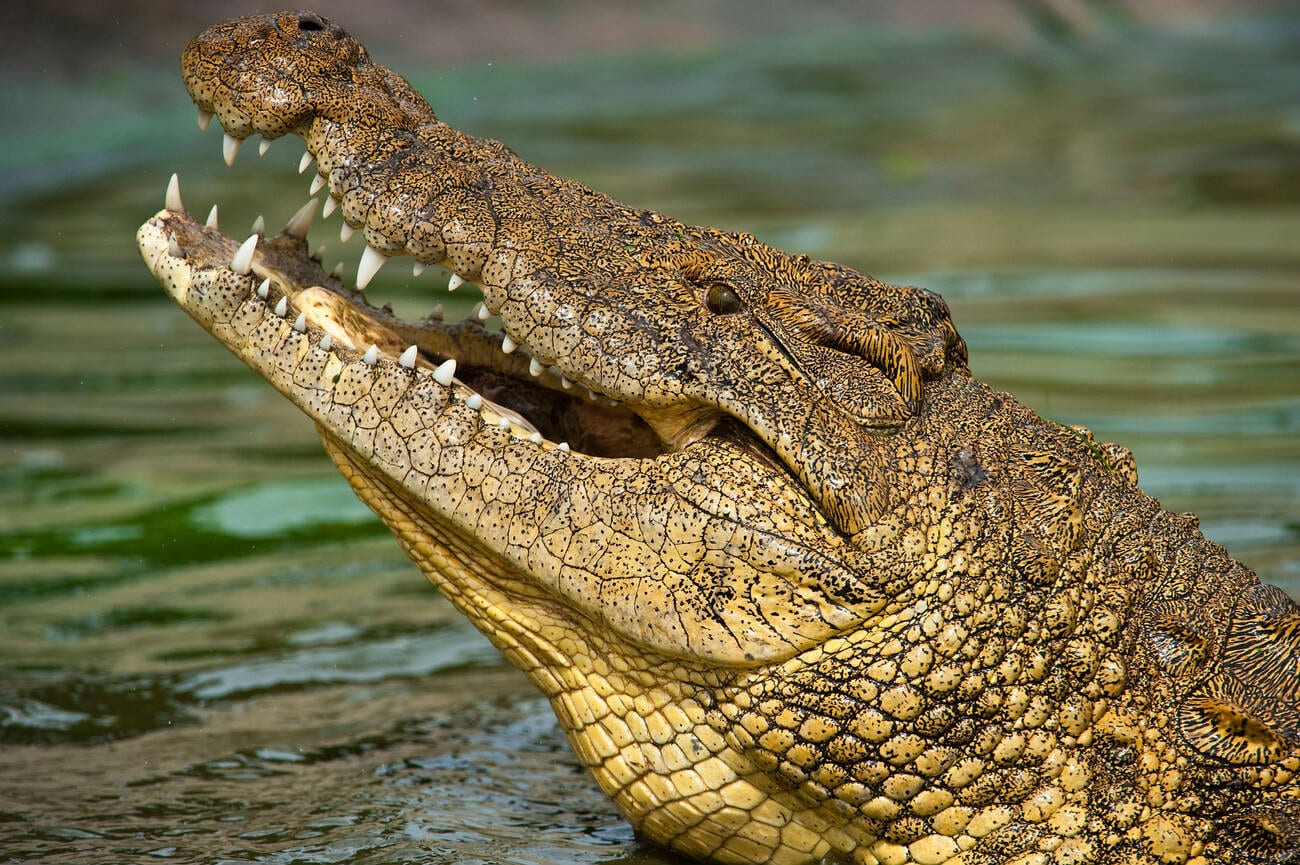
Dive into the pristine landscapes of the National Chambal Gharial Sanctuary, located in Pali, Rajasthan. This sanctuary, carved by the Chambal River, is a sanctuary for the critically endangered Gharial crocodile and various other species.
Established to protect the diminishing population of the Gharial crocodile, the National Chambal Gharial Sanctuary was founded to create a haven for these incredible creatures. This sanctuary is a vital conservation effort for preserving the biodiversity of the Chambal region.
- Wildlife To Watch Out For: The sanctuary is renowned for its Gharial crocodiles, along with the endangered Gangetic river dolphin. The Chambal River also houses numerous species of turtles and a variety of resident and migratory birds, making it a haven for nature enthusiasts.
- Best Time To Visit: The ideal time to explore the sanctuary is from October to March when the weather is pleasant, and wildlife sightings are at their peak. The winter months also attract a multitude of bird species, enhancing the overall experience.
- Safari Fees/ Entry Charges: National Chambal Gharial Sanctuary offers boat safaris, providing a unique opportunity to observe Gharials, crocodiles, and diverse birds along the riverbanks. The entry fees are ₹75 per person and the boat ride costs ₹540 for Indians and ₹940 for foreigners.
- How To Reach?
Pali, with its well-connected roadways, is the gateway to the National Chambal Gharial Sanctuary. The nearest railway station is Pali Railway Station, and the nearest airport is Sanganer International Airport in Jaipur. From Pali, a short journey will take you into the heart of this sanctuary, where the Chambal River unfolds its secrets, inviting you to witness the wonders of Rajasthan’s unique wildlife conservation efforts.
Also Read: Top 12 Historical Places In Rajasthan: Guide To Timeless Wonders
10. Van Vihar Sanctuary, Dholpur
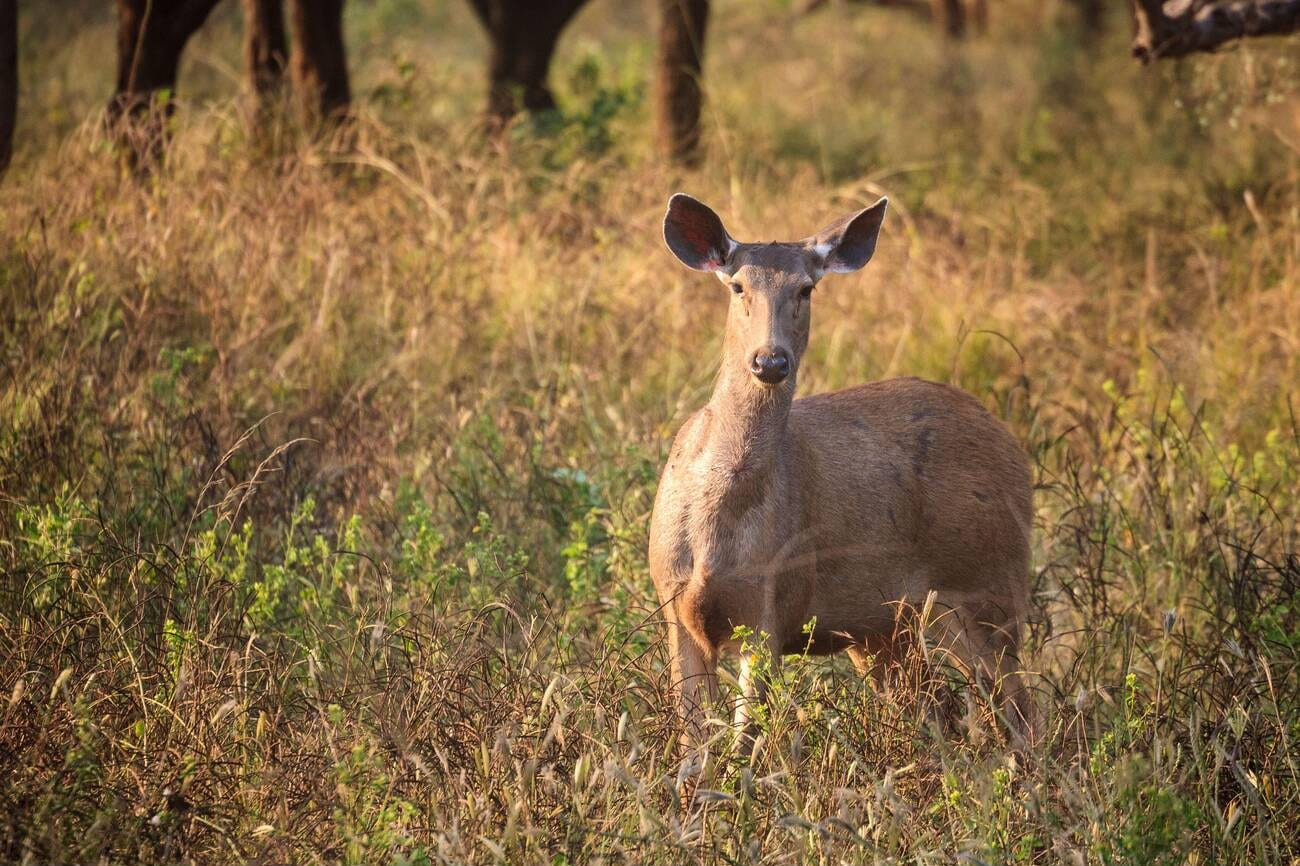
Nestled in the heart of Dholpur, Van Vihar Sanctuary stands as a testament to Rajasthan’s commitment to wildlife preservation. This sanctuary offers a unique blend of natural beauty and biodiversity.
Established to conserve the indigenous flora and fauna, Van Vihar Sanctuary in Dholpur has been a sanctuary since 1955. It serves as a vital refuge for various species, creating a harmonious environment for both wildlife and nature enthusiasts.
- Wildlife To Watch Out For: Van Vihar Sanctuary is home to a diverse array of wildlife, including spotted deer, blue bulls, wild boars, and a variety of bird species. The sanctuary’s landscape, with its water bodies and lush greenery, provides a picturesque setting for observing these creatures in their natural habitat.
- Best Time To Visit: The ideal time for a wildlife jungle safari in Rajasthan’s Van Vihar Sanctuary is during the winter months, from October to March, when the weather is mild and wildlife is more active. The pleasant climate enhances the overall experience, making it perfect for nature walks and bird watching.
- Safari Experience: Van Vihar Sanctuary offers a serene environment for nature lovers. While there are no specific safari options, visitors can embark on guided walks to witness the sanctuary’s flora and fauna up close. The peaceful atmosphere allows for a leisurely exploration of the sanctuary’s natural beauty.
- How To Reach?
Dholpur is well-connected by road and rail. The nearest railway station is Dholpur Junction, and the nearest airport is Kheria Airport in Agra, approximately 56 kilometers away. Accessible by road, Van Vihar Sanctuary invites you to step into the tranquility of Rajasthan’s wildlife sanctuaries, offering a delightful escape into the heart of nature.
Conclusion
In conclusion, Rajasthan’s wildlife safari experience is a captivating journey that seamlessly blends the regal heritage of the past with the untamed beauty of nature. From the iconic Ranthambore National Park to the lesser-explored gems like Jawai Leopard Reserve and Van Vihar Sanctuary, each destination offers a unique glimpse into Rajasthan’s rich biodiversity.
The state’s commitment to wildlife conservation is evident in the well-preserved sanctuaries, making it a haven for wildlife enthusiasts and nature lovers alike. Embarking on a wildlife safari in Rajasthan is not just a wildlife adventure; it’s an immersive encounter with the diverse ecosystems that thrive in this vibrant region.
Are wildlife safari bookings required in advance?
It is advisable to book wildlife safari experiences in Rajasthan in advance, especially during the peak tourist seasons. Booking in advance ensures availability and allows for a smoother and well-organized safari experience, providing the opportunity to choose preferred safari types and time slots.
When is the best time to go on a wildlife safari in Rajasthan?
The best time for a wildlife safari in Rajasthan is typically from October to April. During these months, the weather is pleasant, and the wildlife is more active, providing a rewarding safari experience. However, specific peak seasons may vary slightly depending on the particular wildlife reserve.
What types of safaris are available in Rajasthan's wildlife reserves?
Rajasthan offers a range of safari options, such as Jeep Safaris, Canter Safaris, and nature walks. Jeep Safaris are ideal for a more intimate wildlife encounter, accommodating a limited number of people, while Canter Safaris provide a larger group experience. Nature walks allow visitors to explore the flora and fauna on foot, offering a different perspective of the wildlife.
Where can one experience wildlife safaris in Rajasthan?
Wildlife safaris in Rajasthan can be experienced in various national parks and sanctuaries, including the renowned Ranthambore National Park, Sariska Tiger Reserve, Desert National Park in Jaisalmer, and Jawai Leopard Reserve in Pali.





